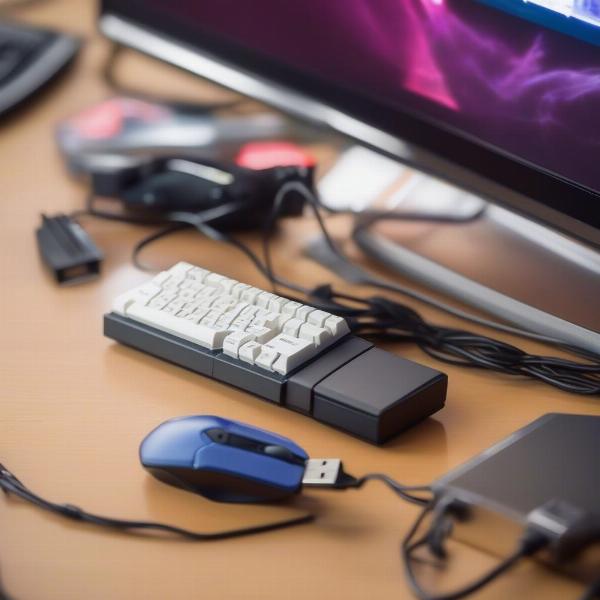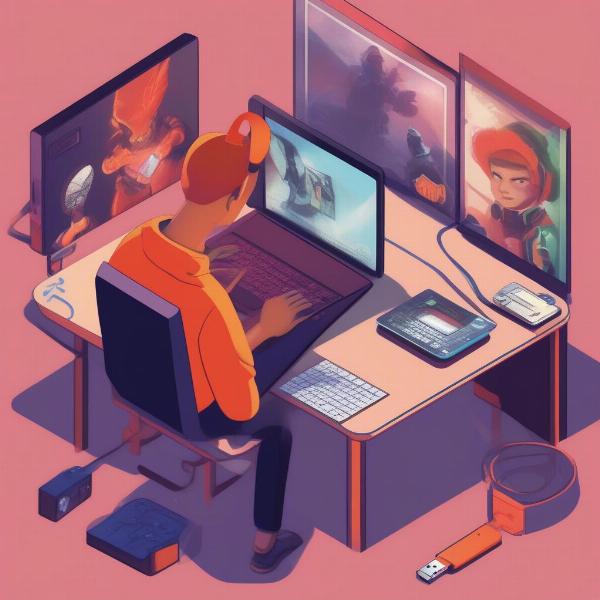The question, “Can I Put A Game On A Flash Drive?” is a common one for gamers, and at SupremeDuelist.blog, we understand the need for flexible game storage. Many gamers find themselves needing to transfer their games between computers or simply want to back up their precious digital collections. This article will explore whether using a flash drive for games is viable, the limitations you might encounter, and how to make it work effectively.
In this guide, we’ll break down the technical aspects, the practical considerations, and provide tips to help you decide if a flash drive is the right solution for your gaming needs. We’ll also address common questions, ensuring you have a complete understanding before you start transferring your games. Let’s dive in and explore the world of portable gaming storage, and just like how we cover [single player games that can’t be played anymore], we’ll ensure you get a complete picture.
The Basics: Understanding Flash Drives and Games
Before we get into the nitty-gritty of using a flash drive for gaming, let’s lay a foundation. A flash drive, often called a USB drive or thumb drive, is a portable storage device that uses flash memory. This solid-state technology allows for quick access to stored data, making it different from traditional mechanical hard drives. Games, on the other hand, vary widely in size, from small indie titles to large AAA releases that require many gigabytes.  gaming-on-usb-flash The crucial point here is understanding the space your games require and the capacity limitations of flash drives.
gaming-on-usb-flash The crucial point here is understanding the space your games require and the capacity limitations of flash drives.
Can You Technically Store Games on a Flash Drive?
Yes, absolutely. Technically, you can store games on a flash drive. Flash drives, like any storage medium, are capable of holding files, and game files are no exception. Whether it’s the installation files for a game or the entire game folder itself, a flash drive can act as a repository. The real question is whether it’s a good idea and whether the game will be playable directly from the drive without issue. Understanding the difference between storage and playability is key.
What are the Limitations of Using a Flash Drive for Games?
While feasible, using a flash drive for gaming has several limitations. Speed is a significant factor. Flash drives, especially older or budget models, have slower read and write speeds than internal SSDs or even some external hard drives. This can impact loading times and performance, leading to stuttering and lag in games. Another consideration is capacity. Flash drives often have limited storage, typically topping out at 256GB or 512GB. Modern games often require tens of gigabytes, sometimes over 100GB for AAA titles, so a typical flash drive may not be sufficient for a large library. You may also face the issue of heat management when pushing a flash drive for extended play sessions, although these risks are relatively low for most users. It’s important to remember, much like with [can you play games from an external hard drive], that not all storage solutions are created equal.
How to Put a Game on a Flash Drive
Transferring a game to a flash drive isn’t a complex process but there are a few approaches you can take. The most common methods include directly copying the game folder and using backup utilities. Let’s explore both.
Directly Copying the Game Folder
This is the simplest method. If a game is portable, meaning it doesn’t rely heavily on system installations and can run directly from its folder, then you can directly copy the game folder to the flash drive. The process involves finding the game folder on your computer and dragging and dropping it onto your flash drive. However, this often only works with older games or indie titles that don’t require registry entries or other installation steps. This method is similar to how [this game can be transferred locally] between computers, where portability is a key factor.
Using Game Backup Utilities
Many game platforms offer backup utilities that compress game files into a single file or a series of files which can be restored on a different computer. This method works well for games tied to platforms like Steam or GOG. These backup files can be transferred to a flash drive and restored on another computer. This is a cleaner method that also ensures that all associated files required for proper game operation are included. The drawback, is that you will need to restore the game on another machine before being able to play it.
Step-by-step Guide to Copying Game Files to a Flash Drive
- Locate the game folder: Find the installation folder of the game you wish to transfer.
- Connect your flash drive: Plug your flash drive into your computer.
- Copy the game folder: Drag and drop the game folder from your computer to your flash drive.
- Wait for the transfer to complete: Be patient and wait for the copy process to finish. The time will depend on the game size and your flash drive speed.
- Eject the flash drive safely: Always use the “safely eject” option to avoid data corruption.
Can You Play Games Directly From a Flash Drive?
This is where things get more interesting and, unfortunately, more complicated. While you can store game files on a flash drive, playing them directly can be tricky and often results in reduced performance, especially on modern games that are built to leverage faster storage mediums. The game has to load files from the flash drive in real-time and any slowdown in reading those files from a flash drive will result in stuttering and lag. This also introduces an additional point of failure as any issues with the USB connection could cause problems. The answer to the question, “can you store games on a flash drive?”, is always a resounding yes, but “can you play them smoothly” is far less clear.
Factors Affecting Performance
Several factors influence how well games will run from a flash drive. These include the speed and type of your flash drive, the type of game, and the hardware of the computer you’re running the game on. Older, simpler games or emulators might run fine, while demanding AAA titles are likely to suffer from long load times, stuttering, and reduced graphics quality. We will go into more detail on these factors below.
Types of Flash Drives: USB 2.0 vs 3.0 vs 3.1/3.2
The USB standard of your flash drive is crucial. USB 2.0 has significantly slower read/write speeds compared to USB 3.0 and its successors. A USB 2.0 drive might make even simple games struggle, while USB 3.0, 3.1, or 3.2 drives can offer a more acceptable experience. For best performance, look for USB 3.2 Gen 2 or newer drives which offer the fastest speeds. This aligns with the performance factors we often consider when asking [can you game on a d].
Game Portability: What Makes a Game Suitable for Flash Drives?
Not all games are created equal when it comes to portability. Some games are designed to run from any location, while others rely heavily on system installations, registry entries, and other components. Portable games are easier to run directly from a flash drive. Games that require installation often need more setup beyond simple file transfers.
Optimizing Gaming on a Flash Drive
While performance might be a struggle for many demanding games, there are steps you can take to optimize your experience. Here are some tips to improve game performance when running games directly from a flash drive.
Tips to Enhance Performance
- Use a fast flash drive: Opt for a flash drive with USB 3.2 Gen 2 or newer for the best read and write speeds.
- Check the game’s system requirements: Make sure your computer meets the minimum requirements, as a flash drive won’t magically boost performance if your system is struggling.
- Disable unnecessary background apps: Close any resource-heavy applications running in the background to free up system resources.
- Adjust game settings: Reduce graphics settings to improve performance. Lower resolution, texture quality, and other graphical settings.
- Keep your flash drive free: Try to keep your flash drive from being full, some of the space is usually required by the flash drive itself and leaving a free buffer can improve performance.
- Defragment your flash drive: Windows does not defrag flash drives by default, but if you are moving and deleting files on it, defragging using the “optimize” tool can help slightly with read speeds.
“For optimal gaming experience, consider the USB specification of your flash drive. A USB 3.2 Gen 2 or newer will definitely improve the experience,” advises Michael Thorne, a hardware analyst at Tech Solutions Now. “However, remember that even with the best flash drive, you may still be limited by the nature of flash-based storage versus SSDs”.
Frequently Asked Questions
Here are some of the common questions regarding using flash drives for games:
Can a Flash Drive Damage My Computer if I Run Games Off it?
No, a flash drive will not damage your computer. The worst thing that might happen is a game crashing due to slow load times, but it poses no risk to the computer hardware itself.
Can I Use a USB Hub to Play Games from a Flash Drive?
Yes, you can use a USB hub, but if it’s not a high quality powered hub, it might further slow down read and write speeds to your flash drive. This can be an issue, especially for USB 2.0 hubs.
Is It Better to Use an External SSD Instead of a Flash Drive?
For gaming, yes, absolutely. External SSDs offer much better performance than flash drives due to faster data transfer rates and improved data management capabilities. They’re the ideal choice if you’re looking for the best possible experience.
Can I Store Game Saves on a Flash Drive?
Yes, you can store game saves on a flash drive and move them between computers, though it’s not the most ideal solution. This can work as a temporary solution, but is not usually advised due to the risk of corruption and potential loss of game progress.
What is the difference between USB 3.1 Gen 1 and Gen 2?
USB 3.1 Gen 1 is equivalent to the older USB 3.0 standard, while Gen 2 doubles its speed. Thus, Gen 2 provides faster performance than Gen 1.
“When it comes to choosing a USB for gaming, consider the USB generation and speed first,” notes Sarah Chen, a system engineer. “While the capacity of the drive is important for storage, the speed is critical for gameplay. Remember that performance can vary between devices based on their specific chipsets and controller.”
 portable-gaming-with-flash-drive
portable-gaming-with-flash-drive
Conclusion: Flash Drives as a Gaming Solution
While technically feasible, using a flash drive to store and run games isn’t the most ideal method, especially for demanding modern titles. For those wanting to transfer games, or use older or indie titles this can be useful. It’s best to consider factors like the speed of the flash drive, the game size and portability of the games. Remember, at SupremeDuelist.blog we’re committed to providing you with clear, informative, and reliable guides for all your gaming needs. While a flash drive can sometimes provide a solution, external SSDs remain the best choice for those seeking the best gaming experience.
If you’re exploring different ways to store or play your favorite games, we encourage you to explore our other guides and delve deeper into topics such as whether [can you store games on a flash drive] is the right choice for you.
Leave a Reply